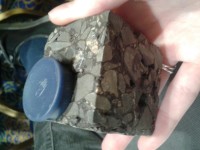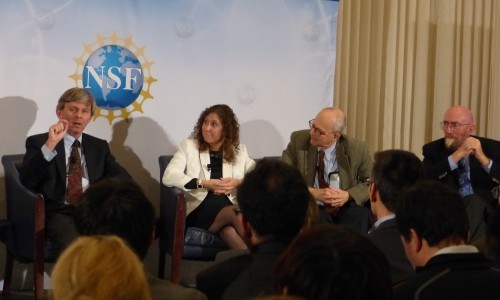Category Archives: AAAS Annual Meeting 2016
Something more concrete

A sample of asphalt to which steel-wool fibres have been added, making the material magnetic.
By Margaret Harris at the AAAS Meeting in Washington, DC
Although Thursday’s LIGO result was extremely exciting, I’m afraid I can only spend so much time pondering ripples in the fabric of space–time before I start yearning for something a little more…concrete. Like, well, concrete. And asphalt. And cement. These decidedly ordinary materials were the stars of two of the most fascinating talks I’ve seen at the AAAS meeting here in Washington DC over the past two days.
First up was Erik Schlangen, a civil engineer at the Delft University of Technology in the Netherlands who develops “self-healing” materials. One of his projects (which you can watch him demonstrate in a TED talk) involves mixing porous asphalt with fibres of steel wool. The resulting conglomerate is magnetic (that’s a magnet sticking to it in the photo), which means that microscopic cracks in it can be repaired using induction heating. The heat melts the bitumen in the asphalt, allowing it to re-fuse, but the surrounding aggregate remains relatively cool – meaning that cars can be driven over asphalt road surfaces almost as soon as the repair is complete.
View all posts by this author | View this author's profile
Science that goes ‘chirp’ in the night

LIGO leaders at the press conference (from left): executive director David Reitze, spokesperson Gabriela González, Rai Weiss and Kip Thorne.
By Margaret Harris at the AAAS meeting in Washington DC
Not with a bang, but a chirp.
That’s how the 2016 meeting of the American Association for the Advancement of Science (AAAS) kicked off on Thursday, thanks to the spectacular news that the Laser Interferometer Gravitational-wave Observatory (LIGO) has, for the first time ever, directly observed the ripples in space–time known as gravitational waves. As our news story explains, LIGO’s twin interferometers picked up the waveform produced as two black holes spiralled into each other, emitting gravitational waves at frequencies and amplitudes that rose sharply with time, like the chirp of a cricket.
The LIGO researchers announced their discovery at a packed press conference in downtown Washington, DC. The excitement in the room was palpable, even though, as it turned out, most of the journalists present already knew what they were about to hear. This actually isn’t unusual. It’s common practice for scientific journals to send new research papers to journalists a few days ahead of publication; the idea behind this so-called embargo system is that it gives journalists time to report accurately on complex science stories.
What was unusual was that this time, there was no embargoed paper. Instead, there was a vigorous rumour mill casting out information in a messy, somewhat underhand and highly anisotropic way. This is rather interesting, and I wish that LIGO’s Gabriela González hadn’t dismissed the journalist who asked about it with an incredulous “The facts are so beautiful – why do you talk about rumours?”